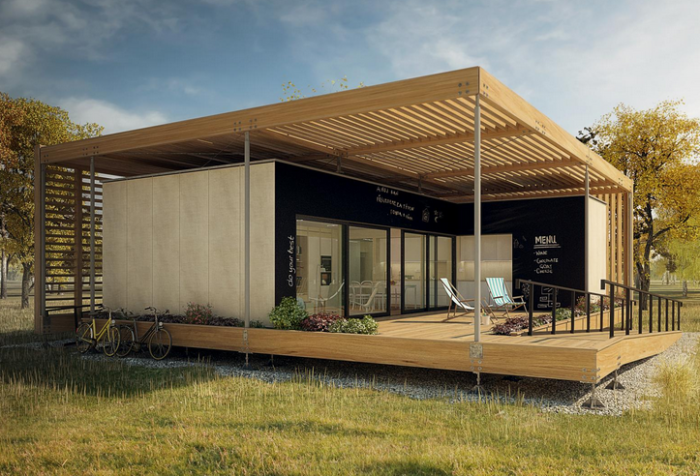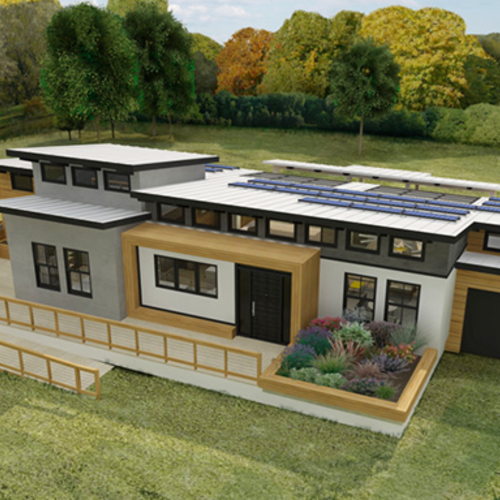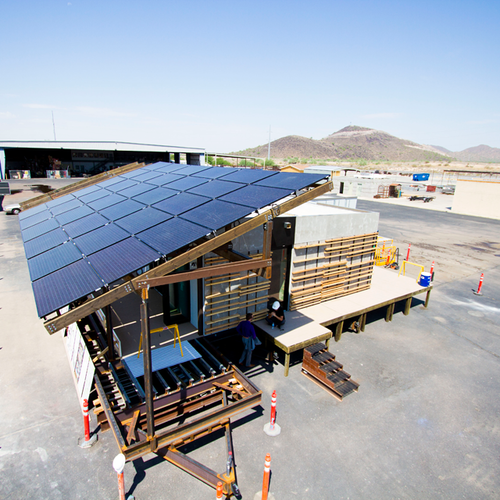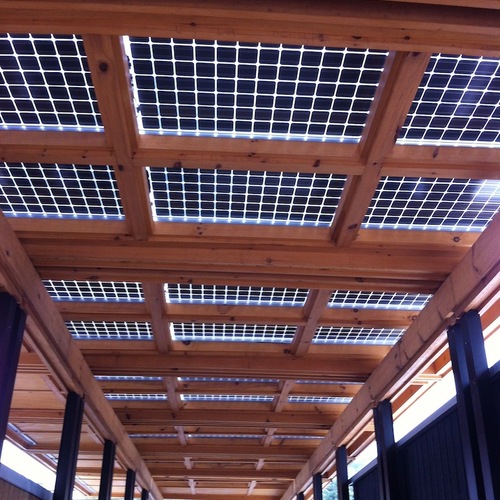Image Credit: Airhouse.cz
Image Credit: Airhouse.cz The wood louvers provide a little bit of privacy, while still allowing for a view.
Image Credit: www.facebook.com/Solardecathlon2013.Prague/photos_stream Three types of double skin façades.
Image Credit: T. M. Boake
This year, the U.S. DOE Solar Decathlon moved from its historic location on the Washington , D.C. Mall to Irvine, California — a very prescient move considering the current government closure of the Mall. The Decathlon concept has expanded to a Solar Decathlon in Europe in 2012 and China in 2013, and the recent U.S. event was open to overseas contestants. Among the many university teams vying for a chance to compete, teams from Austria and the Czech Republic succeeded in securing spots among the 20 finalists.
The goal of the competition is to design, build, and operate a solar-powered house, which is judged on cost-effectiveness, energy efficiency, and design aesthetics. Projects are also scored on engineering, communication and home entertainment.
The AIR House is meant to be a prototype for an affordable (A), innovative (I), and recyclable (R) house. It has become a media darling — reviewed by Architect magazine, Inhabitat, Ecobuilding Pulse, and likely a few more before the contest is over. The AIR house appeals on many levels. It has a very light environmental footprint, due to its low-waste prefab process, the net-zero operating costs, and the design for disassembly and recycling at the end of the service life.
Flex spaces and multipurpose rooms
Of course, it has all the expected technology — a solar thermal system, PV, and a heat-recovery ventilator — as well as the unexpected technology, such as a radiant chilled ceiling system and a graywater system that feeds into the garden.
Designed for retired seniors, it does not make any of the concessions of starter houses and manages instead to neatly package full functionality and comfort into the small footprint by optimizing the spacial layout. The multipurpose room has lots of built-in closets and functional flex spaces. Sliding glass doors provide the flow onto a deck, where a small vegetable garden continues the visual link to the outdoor landscape.
Wood louvers make a house-within-a-house
But the most interesting aspect from the perspectives of both design and energy is the “house within a house” concept. The mechanical room is at right angles to the main living space, and the two wings create an “L” shape that defines the patio. This entire rectangle of indoor/outdoor living space is nested within a second structure of wood louvers that extend over the roof and around three walls. These walls are spaced far enough away from the primary structure to create a surrounding deck that has some degree of privacy, yet offers filtered views of the outside.
This wooden canopy gives a bit of the sense of living in a treehouse, protected from winds and filtering the sunlight. The effect of this soft boundary is very organic, as if the house “breathes” through the louvers. And it immediately calls to mind a lush tree garden landscape setting, almost as another layer of this design.
Many architects have experimented with double skin façades
Double skin façades (DSF) are not a new invention. It might be said that the brush shelters built over the top of Navajo hogans are a type of double roof. In the U.S., there was renewed experimentation in the 1970s with double walls and extracted air systems based on the principles of passive solar thermal chimneys. In some designs, the buffer space was large enough for a greenhouse accessed from inner windows. Of course, the realities of such designs were complicated by humidity build-up, air not moving at predicted rates of speeds, and the difficulty of keeping the space free of bugs, critters, and greenhouse debris.
In general, the DSF technique is more typically used in commercial construction, where a secondary exterior glass skin can provide maximal daylight, a sound buffer, and insulation separate from the structural exterior wall. DSFs are categorized by the direction of the air flow: they can be buffers of supply / return air (from indoor air or outdoor air), or a space for exchanging air from inside to outside, or outside to inside.
One of the best references for double-skin façades is the Oesterle book by the same name, documenting many of the existing uses of DSF in Europe. This technique is also gaining popularity in Asian cities, in the glass building skyscraper cities. But the cost and degree of difficulty in accurately modeling the effect of the two thermal envelopes and the air flow remains a major roadblock to mass market adoption.
A boring shape becomes interesting
There is beauty in the simplicity of the louvered shell used in the AIR House. First of all, this is a very easy way to spruce up a very boring box-shaped house, trailer, or even a shed. The basic design can be customized with a bit of creativity in the slat design, keeping in mind the orientation needed for the summer shading. A variation might include plants trellised up the side walls, and the careful selection of plantings in the prevailing wind paths to provide cooling, or even scents of flowers.
In this approach to double-skin façades, the exterior air flows freely through the slats into the buffer space. Here, it is cooled and as the temperatures change, it continues to flow. This would create a nice ventilation effect of continuous moving air. The slats could also be positioned to capture regular wind patterns, to channel them to or from the house as desired.
This application was actually put to the test at the Solar Decathlon site, as the shell protected the house from the worst of the Santa Anna winds and dust. A careful design specific to the site would optimize the passive solar capabilities for summer shading and thus moderate the heat load on the building envelope. But in any case, since the air buffer is not contained in any way, the risks of this DSF approach are low. It seems unlikely to create problems of mold or humidity build-up, and there is nothing mechanical to break. It is very site-specific, but it would seem to be easily modifiable and tweaked to provide the most benefits.
A place to socialize
The Czech entry has particular appeal to me, not only because of my Czech roots (in the land of tennis stars, Vaclav Havel, and great beer) but because I find the design is a breath of fresh air in this contest (pun intended).
The design recognizes that human comfort comes not from a show of technology, but rather from a connection to the natural environment and to other people. It seems to have become a favorite gathering spot for dinner parties, and the space easily accommodates these social activities. We’ll keep our fingers crossed (or as they say in Czech, budeme držet palce, or “hold one’s thumbs”) and wish Team Czech Republic the best of outcomes in their first Solar Decathlon.
[Editor’s note: The results are in: The Czech team won the Architecture category and placed third overall.]
Dr. Vera Novak was recently awarded a PhD in Environmental Design and Planning by Virginia Tech. Her work is dedicated to increased depth and breadth of sustainability in construction, by leveraging the points of greatest potential impact. She is currently working on optimizing corporate sustainability practices to support regenerative design, as well as adapting a lean thinking process for smaller scale projects. She also writes the Eco Build Trends blog.
Weekly Newsletter
Get building science and energy efficiency advice, plus special offers, in your inbox.
















12 Comments
Czech homes don't NEED to withstand Adirondack weather!
I dunno AJ, the solar decathlon entries are never designed to be suitable for every climate, and they clearly aren't. Central European climates are more like US Climate Zone 4 than Zone 6/7, and most the entries seem better suited to the more temperate US zones 2-4 than zones 5+ (or zone 1.)
BTW: I've seen numerous Solar Decathlon entries in Washington DC in prior years from European universities, plenty of entries outside of North America, as well as non-US N.Amer. entries. Indeed, the 2009 outright winner was the Technische Universität Darmstadt (Germany) a repeat of their win in 2007. Universidad Politécnica de Madrid (Spain) has entered multiple times, and in 2011 there were also entries from Ghent University (Belgium) , University of Calgary (the oil exporting center of Canuckistan ;-) ), Tongji University (China), and : Victoria University of Wellington (New Zealand). This is definitely NOT the "...the first time that the U.S. event was open to overseas contestants" as alleged by Vera Novak, but it IS the first time it's been held in California.
Green is what Dana?
Green is in part sustainability which then has me thinking low maintenance. The eye candy project would be a nightmare any where leaves fall and rain falls and sine shines and snow falls. Like the Adirondacks and most of the US and most of the Czech Republic and I bet where this PHD lives.
Who in their right mind would want to clean that exterior?
That project is nice for just about the first week on display then after horrendous incompetence as far as understanding function which is almost always the case with architects that are not also builders.
:)
Adirondacks
The decathlon home design is always in a bit of a quandary, as it must be designed to suit the 'home' climate, but also has to perform well in the competition location. A bit of a challenge from the moderate climate of the Czech Republic to the hot/dry climate of Southern California. They are also designed to be thought provoking - which it has done - based on the comments. The basic concept of house within a house can be modified to suit local climates. For example, the roof structure could be built on a slant, to help leaves and debris get swept off by rain. And this design is clearly better suited to cooling environments, and not snow country. As was pointed out - probably not ideally suited for the Adirondacks. However, as for as durability, the aging of the wood is not so different than clapboard siding, wood shutters or a deck. So not without precedent.
European Entries
Dana - you are quite correct about the international entries in previous competitions. I had edited this out of a final version, but it fell prey to a technical glitch between a PC/ Mac conversion. My error. In fact, the European competition has also been open to US teams. Notably, the 2010 competition was won by Virginia Tech - which is my home University.
comfort
even though the Czech climate differs from SoCal, they were the only team to keep the house in 80F in the comfort competition
http://www.solardecathlon.gov/contest_comfort_zone.html
It looks like nobody turned on their AC, as they were all scared to use up their PV power production. However that was not warranted, since almost all the teams over produced...
one thing that could be a important factor in why the kept their house cool(er) is that they used heavy insulation (woodfiber board/cellulose) and not SIPs and foam...hereby delaying the day/night shift in temps without having to use the AC.
Temperature moderation
Floris - Very interesting observation about upper limit on the temperature. It appears the AIR house definitely had a more consistent temperature overall, with much smaller temperature swings.
Vera,
Go
Vera,
Go hokies!
Historically, hasn't a double facade been a double glazed facade? In all the DSF projects I've seen or worked on, this has been the case. Which also jives with the definitions from the DSF lit review undertaken for the IEA SHC task 34 on double skin facades:
http://www.ecbcs.org/docs/Annex_43_Task34-Double_Skin_Facades_A_Literature_Review.pdf
but i absolutely adore the czech submission. same with the TU Wien house (winner).
Dana,
While the Czech Republic may be milder, all our zone 4 passivhaus projects and other's PHPP files we have, perform significantly worse when migrated to 'mild' Europe. many zone 5 or 6 projects in the US outperform their EU counterparts. I mentioned this at the CANPHI conference, where I wasn't able to find a single person who claimed that the PH standard needed to be 'relaxed'.
https://pbs.twimg.com/media/BUnuB85CcAA6gE1.jpg:large
aj,
Who is cleaning the wood? It's probably siberian larch. Like cedar, only nicer. Weather's to a really nice silvery gray.
Double- Glazed vs Double Skin
MIke - Most of the current DSF projects, and certainly the commercial ones are indeed an additional glazing layer that is set apart from the bearing wall. However, deep in my library is an old residential energy book (70's) depicting some double facades that actually had two full wall structures separated by at least 4 ft. .... New England area - if my memory serves me correctly. The text noted the difficulty of getting the air to behave in the manner for which this system was designed, given the influence of the external thermal environments. The AIRHouse seemed to harken back to this double envelope - giving up some of the thermal benefits by NOT having a sealed area - but also eliminating all of the problems associated with it. The real question is - does just the buffering of air space and the architectural value merit the extra expense and work? Don't know - just throwing it out there for thought.
Double envelope houses
Vera,
Those 1970 experiments were called "double envelope houses."
In addition to the fact that they were expensive to build and had minimal, if any, performance advantages, there were fire-code problems, because flames could race unimpeded through the space between the two walls. Rather than coming up with a way to install expensive fire dampers with fusible links in all of these spaces, designers just abandoned the concept.
Great eye candy design but...
PhD ok.... Picture this build after just ten or twenty years..... In the Adirondacks.
PhD in construction.... But no minor in Adirondack residential apparently..
I do like this contest. Anyone have an idea how this design could be modified to be low maintenance in an Adirondack climate?
The days go by.... My current opinion; absolute worthless design from every angle that counts. Eye candy by itself is.... Worthless.
AIR House
Only 19 entries made it to the competition at the Orange County Great Park in Irvine. Virginia dropped out of the competition because of last minute funding problems.
I did visit all the houses - FOUR days with two of those days in the hot dry winds. Because the winds were blowing so hard - the Solar Declathon was closed until 2:30PM on Friday, October 4th.
AIR House had an interesting design in that the deck could be facing north or south - depending on the climate. And the location. For the contest the deck was facing north - offering more shade -- and potential cooling to the house. When it goes back to Czech - the house could be turned to the south for maximum heat gain. That exterior wood was local spruce... well dried.
Was it effective? I do not believe it worked as well as some of the other house designs. I brought along thermometer and hygrometer. On Friday the RH was below 10% that afternoon. None of the houses should have had any problem keeping below the 60% - that day. And indeed they passed that test. But for some of the houses the indoor humidity also dropped down below 10%. I would like future Solar Declathons to "raise the bar" and require a minimum of 25% humidity in the houses as part of the comfort tests.
The outside temperature on the "main street" of the Solar Declathon was well above 100F, I was seeing in shade temps of 94F, some of the competition houses had outside south facing walls that were above 140F (shoulder height, measured with simple IR -- assumed 0.95 emissivity....) While many of the houses on that Friday remained below 80F inside when I did a quick walk through them - the Czech house felt warm to me when I when through -- high 80's, and it was cooler on the back deck. -- Yes that portion of the design worked. But other houses such as the Ontario team house kept the humidty closer to 20% inside and a cooler temperature also.
Spruce is nice - but I kept thinking with these dry winds and if anyone smokes and there is a fire would they be able to save the house - I doubt it. From the rear deck of the Czech house we could see the smoke from fires in the canyons east of LA. The wood was natural - not treated with fire retarding coatings, nor were steps taken to prevent attacks of wood chompers. It looked pretty for the competition but I could not see it lasting longer than ten years in any of the climates except on an old Marine airbase. I realize that's harsh but but gut reaction was that's a lot of untreated, unprotected wood waiting for something bad to happen.
The Czech house was also one of the more expensive houses - excluding the transportation costs. I believe they lost some points for that - but since their goal was a retirement home - I think they should have lost more points for their higher costs.
While walking through I took lots of pictures, not all of the homes were fully ADA compliant - areas that were not accessible per ADA were roped off. I think the Czech house did well basic wheel chair widths, but if I remember correctly they also stacked their Bosch washer and dryers -- that would be a wheel chair accessible problem...
I do not remember seeing how the house did on its water budget - the dry winds were causing some of the homes problems -- landscaping vegetable gardens and fountains can slurp up the water when hot winds blow.
AIR House / Double Facades
Moore Lyndon Turnbull Whitacker (MLTW) wrapped houses in shade screen back in the 1960s. See http://www.rndrd.com/i/269 for an example. Or look at the book "The Place of Houses". This house is in Virginia, not the Adirondacks. Architecture is supposed to be regionally adapted, right?
Log in or create an account to post a comment.
Sign up Log in